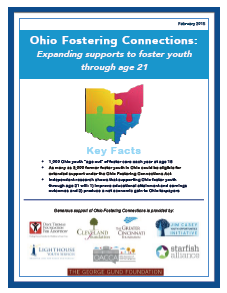Report Released on Cost-Benefit and Program Design

On December 15, 2014, Ohio Fostering Connections released a report on the cost-benefit analysis of implementing the Ohio Fostering Connections Act in Ohio. The report also includes the recommendations on how the program should be designed, implemented, and integrated into Ohio’s community child welfare and housing systems.
The cost-benefit research was conducted by Alvin S. Mares, PhD, MSW, LSW, Assistant Professor of Social Work at The Ohio State University. Dr. Mares is one of the nation’s leading scholars on outcomes of young adults leaving foster care.
The program recommendations are based on feedback received from five community events that were held around Ohio during the summer of 2014. Foster parents, foster youth alumni, child welfare professionals, elected officials, and advocates were active participants.
Key Findings of Cost-Benefit Analysis
- Over a ten year period, Ohio will benefit dollar-for-dollar by providing supportive services to young people who age out of foster care and to those who were adopted from foster care at age 16 or later.
- By year six of the program’s statewide implementation, Ohio will benefit $1.06 for every $1.00 spent.
- By year 10, the benefit will rise to $1.81 for every $1.00 spent, surpassing net costs.
Key Recommendations on Implementation
- The program should be centrally administered by ODJFS and sub-contracted to local agencies. Eligible local agencies should include ODJFS-certified private agencies and public children service agencies.
- Maintain the federal government’s eligibility standards for young adults to enroll in the program.
- Promote a wide array of transitional housing programs for the young adults, including apartment programs, campus housing, and foster and host homes.
Thank you to the hundreds of Ohioans who contributed to the report!

